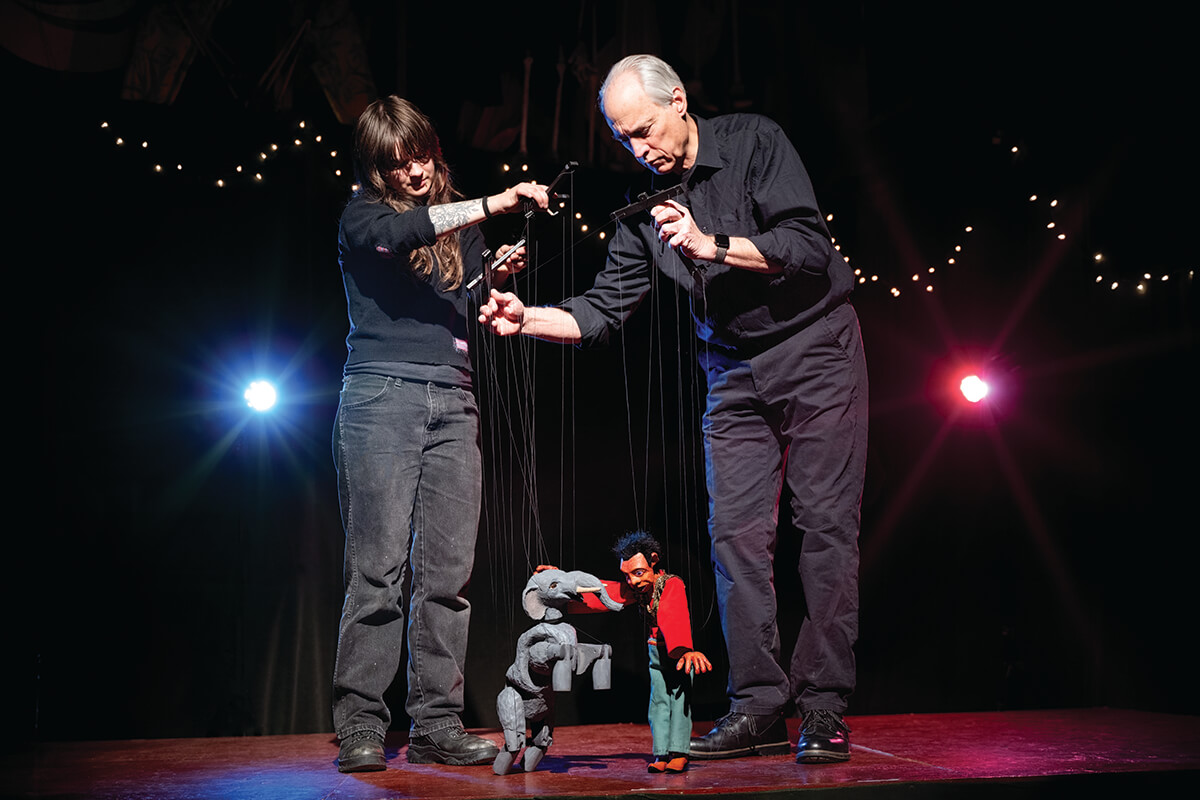Arts & Culture
MICA Students in Need of Summer Jobs Founded the Black Cherry Puppet Theater. It Became an Institution
The Hollins Market nonprofit, which has presented thousands of shows and workshops at schools and festivals throughout the region, turns 45 this summer.

“Before I moved away from Baltimore, I didn’t realize that other cities do not have their own enchanted rowhouses of puppetry,” joked musician Eric Voboril in a short documentary about Hollins Street’s Black Cherry Puppet Theater that came out several years ago.
Michael Lamason, Black Cherry’s 68-year-old executive director, had never attended a puppet show—much less performed with a marionette—when he founded the original troupe with Corliss Cavalieri, Bill Haas, Rick Weiss, and Michael Richardson in the summer of 1980. They were just college kids at MICA and needed jobs and got creative.
Hired by legendary recreation and parks director Virginia Baker, who had been appointed by Mayor William Donald Schaefer to direct a special office he named Adventures in Fun (can we bring that back?), the motley collection of printmakers and painters put on 107 shows for city kids over school break that year.
Decades before YouTube, they taught themselves how to build sets, props, and puppets from Pratt library books, earning $6 an hour for their troubles.
“A small fortune in those days,” Lamason says with a smile in the theater’s Geppetto-like workshop as he stands and manipulates the knees, elbows, and face of a Jack and the Beanstalk marionette he’s been working on. “We were up all night before our first performance, still making everything we needed. No rehearsal, I just went and did the show. I thought it was a mess, but you dance a marionette in front of an audience and nobody has a clue how you’re doing it. They just see you doing this magic on the stage and there’s a suspension of disbelief. They’re transfixed.”
Far from mere child’s play, the ancient Greeks interpreted the Iliad and the Odyssey with puppets. In the Middle Ages, string puppets were used to depict biblical stories, with the Virgin Mary often a central figure (marionette in French means “little Mary”). And in the 18th century, leading composers like Haydn created adult operas specifically for marionettes.
Now in its 45th year, the nonprofit Black Cherry theater has presented thousands of shows and workshops at schools and festivals throughout the city, state, and region. Housed across the street from historic Hollins Market in side-by-side rowhomes, purchased for a grand total of $12,000 in the mid-1990s when crack cocaine was tearing at the fabric of its Sowebo neighborhood, Black Cherry’s central mission—and Lamason’s, too—remains performance.
Its quarterly Puppet Slamwich series for adults features tales and marionettes; ventriloquist dolls; and finger, hand, sock, stick, and shadow puppets of every imaginable variety. The 50-seat black box theater also hosts a variety of musical guests throughout the year, from folk to jazz and classical performers.
The puppet slams, which attract a mix of artist applicants from near and far, always include a musical guest as well, selling out within days of their ticket release. At a recent Slamwich, for example, the first performer was Matt Muirhead, an artist better known for his sci-fi Baltimore landscapes. He used a sock monkey named “Holly” to help tell a nonlinear narrative against a scrolling backdrop that included several of his paintings.
Muirhead was followed by Carmen Houston-Ludlam, a 27-year-old woman from southern Anne Arundel County with Down syndrome, who performed a ventriloquist act with a mermaid, cracking up the crowd with her hand puppet’s irreverent jokes about its shoe fetish and waterbed.
Lindsey Ball, an artist and past National Puppetry Festival coordinator from Chicago, used a toy-sized theater, a crankie, shadow puppets, and recorded voice-over to share a moving personal story that also honored the struggles of those in the LGBTQ+ community who came before her.
“I’ve always wanted to come to Baltimore and be a part of a Black Cherry show,” Ball said later. “The city’s support here for such a labor of love is amazing.”
After intermission and a musical interlude from a banjo, fiddle, and guitar combo, Houston Ludlam, still in the sparkling black dress that she performed in, slid into a folding chair with some popcorn to watch the rest of the show alongside her parents. Seated next to her in the back row, an audience member quietly congratulated her on her flawless performance as the second half began.
“I’ve been practicing for three years, but only in front of my friends and family,” she whispered back, beaming. “This was my first time on stage. My knees were nervous when I started. But only my knees.”